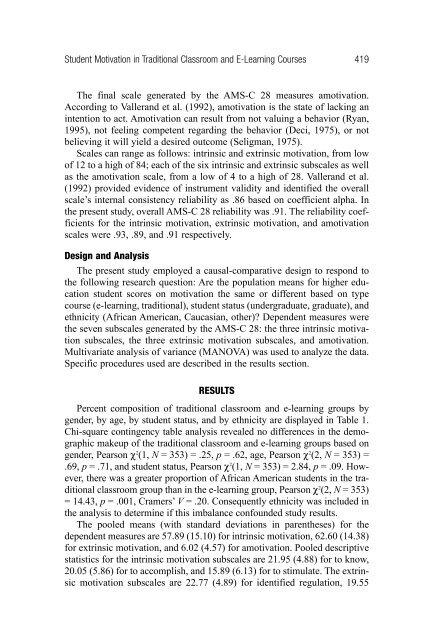A Comparative Analysis of Student Motivation in ... - Anitacrawley.net
A Comparative Analysis of Student Motivation in ... - Anitacrawley.net
A Comparative Analysis of Student Motivation in ... - Anitacrawley.net
You also want an ePaper? Increase the reach of your titles
YUMPU automatically turns print PDFs into web optimized ePapers that Google loves.
<strong>Student</strong> <strong>Motivation</strong> <strong>in</strong> Traditional Classroom and E-Learn<strong>in</strong>g Courses 419The f<strong>in</strong>al scale generated by the AMS-C 28 measures amotivation.Accord<strong>in</strong>g to Vallerand et al. (1992), amotivation is the state <strong>of</strong> lack<strong>in</strong>g an<strong>in</strong>tention to act. Amotivation can result from not valu<strong>in</strong>g a behavior (Ryan,1995), not feel<strong>in</strong>g competent regard<strong>in</strong>g the behavior (Deci, 1975), or notbeliev<strong>in</strong>g it will yield a desired outcome (Seligman, 1975).Scales can range as follows: <strong>in</strong>tr<strong>in</strong>sic and extr<strong>in</strong>sic motivation, from low<strong>of</strong> 12 to a high <strong>of</strong> 84; each <strong>of</strong> the six <strong>in</strong>tr<strong>in</strong>sic and extr<strong>in</strong>sic subscales as wellas the amotivation scale, from a low <strong>of</strong> 4 to a high <strong>of</strong> 28. Vallerand et al.(1992) provided evidence <strong>of</strong> <strong>in</strong>strument validity and identified the overallscale’s <strong>in</strong>ternal consistency reliability as .86 based on coefficient alpha. Inthe present study, overall AMS-C 28 reliability was .91. The reliability coefficientsfor the <strong>in</strong>tr<strong>in</strong>sic motivation, extr<strong>in</strong>sic motivation, and amotivationscales were .93, .89, and .91 respectively.Design and <strong>Analysis</strong>The present study employed a causal-comparative design to respond tothe follow<strong>in</strong>g research question: Are the population means for higher educationstudent scores on motivation the same or different based on typecourse (e-learn<strong>in</strong>g, traditional), student status (undergraduate, graduate), andethnicity (African American, Caucasian, other)? Dependent measures werethe seven subscales generated by the AMS-C 28: the three <strong>in</strong>tr<strong>in</strong>sic motivationsubscales, the three extr<strong>in</strong>sic motivation subscales, and amotivation.Multivariate analysis <strong>of</strong> variance (MANOVA) was used to analyze the data.Specific procedures used are described <strong>in</strong> the results section.RESULTSPercent composition <strong>of</strong> traditional classroom and e-learn<strong>in</strong>g groups bygender, by age, by student status, and by ethnicity are displayed <strong>in</strong> Table 1.Chi-square cont<strong>in</strong>gency table analysis revealed no differences <strong>in</strong> the demographicmakeup <strong>of</strong> the traditional classroom and e-learn<strong>in</strong>g groups based ongender, Pearson χ 2 (1, N = 353) = .25, p = .62, age, Pearson χ 2 (2, N = 353) =.69, p = .71, and student status, Pearson χ 2 (1, N = 353) = 2.84, p = .09. However,there was a greater proportion <strong>of</strong> African American students <strong>in</strong> the traditionalclassroom group than <strong>in</strong> the e-learn<strong>in</strong>g group, Pearson χ 2 (2, N = 353)= 14.43, p = .001, Cramers’ V = .20. Consequently ethnicity was <strong>in</strong>cluded <strong>in</strong>the analysis to determ<strong>in</strong>e if this imbalance confounded study results.The pooled means (with standard deviations <strong>in</strong> parentheses) for thedependent measures are 57.89 (15.10) for <strong>in</strong>tr<strong>in</strong>sic motivation, 62.60 (14.38)for extr<strong>in</strong>sic motivation, and 6.02 (4.57) for amotivation. Pooled descriptivestatistics for the <strong>in</strong>tr<strong>in</strong>sic motivation subscales are 21.95 (4.88) for to know,20.05 (5.86) for to accomplish, and 15.89 (6.13) for to stimulate. The extr<strong>in</strong>sicmotivation subscales are 22.77 (4.89) for identified regulation, 19.55
















